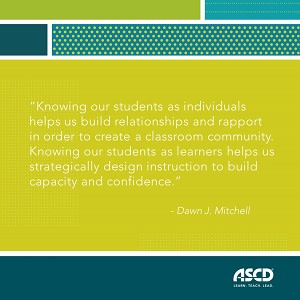Though no instructional strategy is better than another, some strategies are more appropriate or applicable to specific content, learners, or purposes. The strategy suggestions in my earlier post on math and ELLs post can be used with any content, as can the strategies below. Increasing the achievement of ELLs and struggling learners is all about finding ways to help them understand content so meaningful learning can take place.
Manage Vocabulary
The days of kill-and-drill vocabulary tests are over—or should be, if long-term retention is the goal. Student success in vocabulary-heavy courses increases exponentially when students have a system and a clear expectation for the vocabulary they are learning. Below are my three favorite strategies I share most often regarding vocabulary.
1. Choose targeted vocabulary to teach.
Predetermining the vocabulary most crucial to comprehension will help students build a content knowledge foundation. Yes, we want students to learn all of the vocabulary, but if we expect them to learn everything, their learning begins to resemble tossing spaghetti at a wall: some sticks and some doesn’t. Focus their attention on vocabulary that will give the most bang for your buck, and cultivate deeper connections with those words before expanding the list.
2. Have students create a vocabulary collection tool.
Having vocabulary disappear into the abyss of the student mind is easy to remedy by providing a word collection tool for reference and reflection. Just putting vocabulary worksheets in a binder doesn’t help retention. Have students collect and interact with words in a dedicated notebook. Provide students with templates such as a Frayer model to help establish word relationships.
3. Create vocabulary connections.
After you’ve crammed for an exam, what happens to that information once the test is over? Bits and pieces might remain, but the brain is not built for intensive, short-term recall of content learned in isolation. Help boost recall and usage by teaching explicit connections between old and new vocabulary words, and how new terms relate to previous words and concepts through word walls, webs, or mind maps.
Build Background
Whether through interrupted schooling or late entry, students come to class with varying levels of previous knowledge. Informally probing students’ prior knowledge before presenting new content can greatly improve comprehension. And knowing what students know (or don’t) offers insight to help instructors focus new learning.
Use simple resources and mini-lessons to bridge content gaps. Building knowledge doesn’t require entire class periods and elaborate preparation. Find videos, simple picture books on the same content, lower reading level texts, podcasts, or websites for students to sample in-class or independently.
Use Visuals
More than other content, success in science and social studies relies on a student’s ability to comprehend specific vocabulary and abstract concepts and to recall terms so that they can be connected to new learning. Visuals offer an instant, concrete connection to words and concepts that might otherwise linger in uncertainty. A variety of regalia, props, basic websites, historical documents, scientific illustrations and charts, maps, and timelines are excellent supplements.
The depth of prior knowledge and intensity of new vocabulary required to master science and social studies content can intimidate both struggling students and ELLs. Put students in control of their own learning by supplementing difficult content with research-based strategies and watch them soar!
More from Beth Morrow. Beth Morrow teaches middle school ESL in Columbus City Schools in Columbus, Ohio. She also blogs on educational and classroom issues at www.canwejustread.com. Connect with her on Twitter: @BethFMorrow.








